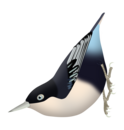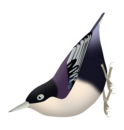Blue nuthatch
| Blue nuthatch | |
|---|---|

| |
| Blue nuthatch at Cibodas Botanical Garden, Java, Indonesia | |
| Scientific classification | |
| Domain: | Eukaryota |
| Kingdom: | Animalia |
| Phylum: | Chordata |
| Class: | Aves |
| Order: | Passeriformes |
| Family: | Sittidae |
| Genus: | Sitta |
| Species: | S. azurea
|
| Binomial name | |
| Sitta azurea Lesson , 1830 | |

| |
| Blue nuthatch range | |
| Synonyms[2] | |
|
• Callisitta azurea (Lesson, 1830) | |
The blue nuthatch (Sitta azurea) is a bird
The blue nuthatch's ecology is poorly known, but it feeds on small
Three
Taxonomy
The blue nuthatch was first described in 1830 under its current
The nuthatches constitute a
In 2014, Eric Pasquet and colleagues published a
Nuthatch phylogenic detail according to Pasquet, et al. (2014):[10]
- Weakly-supported clade
- Brown-headed nuthatch (S. pusilla)
- Pygmy nuthatch (S. pygmaea)
- canadensis group
- Blue nuthatch (S. azurea)
- Velvet-fronted nuthatch (S. frontalis)
- Sulphur-billed nuthatch (S. oenochlamys)
Subspecies
There are three recognized subspecies of the blue nuthatch.[14]
- S. a. expectata (Hartert, 1914), described in 1914 by German ornithologist Ernst Hartert as Callisitta azurea expectata from a holotype taken in the Malay Peninsula's Semangko Pass in Pahang;[15] it is also found in Sumatra;[14]
- S. a. nigriventer (Robinson & Kloss, 1919), described in 1919 by British zoologists Cecil Kloss as Poliositta azurea nigriventer from a holotype taken at Mount Gede[16] in West Java, Indonesia.[14] British ornithologist William Swainson had described the subspecies under the name dendrophila flavipes in 1838, but the name was subsequently little used, and can be considered a nomen oblitum ("forgotten name");[17]
- S. a. azurea (Lesson, 1830) the nominate subspecies, was described in 1830 by René Lesson[3] from a specimen possibly taken on the Arjuno-Welirang stratovolcano; inhabits central and eastern Java.[14]
Description
The blue nuthatch is a medium-sized nuthatch that has an average length of 13.5 cm (5.3 in). The weight is not known,[18] but may be comparable to the Algerian nuthatch (Sitta ledanti), which also measures 13.5 cm (5.3 in) long, and weighs between 16.6 g (0.59 oz) and 18 g (0.63 oz).[19] Its appearance differs significantly from all other nuthatches. All of its subspecies are broadly black and white[20] (especially when viewed in low-light conditions in which their dark blue coloring is not apparent) and have upper plumage shot through with dramatic notes of cobalt, azure and other lighter shades of blue, as well as grays and purples. The head is black, or blackish-blue with a broad, pale blue eye ring.[21][22]
The three subspecies vary predominantly in the coloring of their mantles, chests and bellies. The upperparts are dark blue at the mantle or purplish in some subspecies. The
The species displays no significant
- The three subspecies of the blue nuthatch and their distinct morphological characteristics
-
Sitta azurea expectata - note the dark blue upper parts and azure coverts.
-
Sitta azurea azurea - note the purple upper parts and violet coverts.
-
Sitta azurea nigriventer - note the purplish-blue upper parts, blue coverts and buff-colored belly.
Vocalizations
The species' vocalizations include a melodious tup or tip, a sudden whit, a thin hissing sit, and a fuller, harder, and more forceful chit. When excited, sit and chit notes are frequently given quickly and repetitively as a chi-chit, chit-chit-chit or chir-ri-rit, which can be prolonged, accelerated into staccato trilling tititititititik, or even becoming a rattling tr-r-r-r-r-r-t. Other calls include a thin, squeaking zhe and zhe-zhe, a squeaky toy-like nasal snieu or kneu, and a buzzy chirr-u. The vocal repertoire of the blue nuthatch is quite varied and is reminiscent of the velvet-fronted nuthatch and, to a lesser extent, the sulphur-billed nuthatch.[12]
Behavior and ecology
The blue nuthatch is very active, often seen running in pairs,[23] in larger groups, or mingling in mixed-species foraging flocks.[24]
Diet
The blue nuthatch feeds on
Breeding
The breeding of the species has not been extensively studied. The nest is made in a small tree hole in which it lays three to four dirty-white eggs, washed in lavender and densely speckled with reddish-brown and gray, that measure 19.3 mm × 13.4 mm (0.76 in × 0.53 in). In Peninsular Malaysia, juveniles just reaching maturity were observed in late June; on the island of Java, the breeding season takes place from April to July, and on Sumatra an adult feeding its young was observed on May 9.[24]
Predation
Little has been specifically reported on blue nuthatch predators, but one individual was seen to freeze during the passage of a prospecting black eagle (Ictinaetus malayensis).[23]
Distribution and habitat
In Sumatra, the bird is found throughout the Barisan Mountains, and has been observed in the Gayo Highlands of Aceh province, the Batak Highlands of northern Sumatra, and at Dempo in the south of the island.[24] In a 1918 expedition by Robinson and Kloss, they commented: "from the commencement of heavy jungle on the valley slopes up to about 8,000 feet on Korinchi Peak this strikingly coloured little Nuthatch was very common, feeding on tall tree trunks in parties of six or seven."[27]
The blue nuthatch is typically found on mountains, inhabiting
Threats and protection
The blue nuthatch is a common bird in Sumatra, including in the area of
Footnotes
- ^ Being Callisitta, Poecilositta, Oenositta, Sitta, Mesositta, Micrositta and Leptositta.[8]
- ^ The 21 species are out of 24 recognized as making up the genus by Harrap and Quinn as of 1996. Of these, the study omitted the Indian nuthatch (Sitta castanea), the yellow-billed nuthatch (Sitta solangiae) and the white-browed nuthatch (Sitta victoriae). The International Ornithological Congress however recognized 28 species as of 2012, based on the elevation of four taxa from subspecies to full species status, including Przevalski's nuthatch (S. przewalskii) and three species from the europaea group.[10]
Citations
- ^ . Retrieved 12 November 2021.
- ^ Dickinson, Edward C.; Loskot, Edward C.; Loskot, Vladimir M.; Morioka, Hiroyuki; Somadikarta, Soekarja (2000). "Systematic notes on Asian birds. 66. Types of the Sittidae and Certhiidae". Zoologische Mededelingen (80): 287–310.
- ^ OCLC 768399957.
- ISBN 0-8165-2149-2.
- ISBN 978-1-4081-2501-4.
- ^ Matthysen 2010, p. 4.
- ^ " Entry for 'Nuthatch' ". Oxford English Dictionary. Oxford University Press. Retrieved April 17, 2014.
- ^ a b Matthysen 2010, p. 269–270.
- ISBN 978-0-679-45123-5.
- ^ S2CID 17637707.
- ISSN 0024-0672.
- ^ .
- S2CID 216391261. Retrieved 2021-12-22.
- ^ a b c d e "Nuthatches, Wallcreeper, treecreepers, mockingbirds, starlings & oxpeckers". Version 6.4. International Ornithological Congress (IOC) World Bird List. October 22, 2016. Family Sittidae. Archived from the original on December 22, 2016.
- OCLC 761190665.
- ^ Robinson, Herbert Christopher; Kloss, Cecil Boden (1919). "New subspecies of Malay birds: Poliositta azurea nigiventer". Bulletin of the British Ornithologists' Club. XL. British Ornithologists' Club: 17.
- OCLC 700480502. Archived from the originalon 2016-03-04. Retrieved 2014-05-14.
- ^ Harrap 1996, p. 169.
- ^ Harrap 1996, pp. 135–138.
- ^ Harrap 1996, pp. 48–49.
- ^ ISBN 978-1-4262-0403-6.
- ^ a b c Harrap 1996, pp. 168–169.
- ^ ISBN 978-0-7136-6534-5.
- ^ a b c d e f g h Harrap 1996, p. 168.
- ^ Becking, J. H. (1989). "Diets of Javanese birds". In Brill Archive (ed.). Henri Jacob Victor Sody (1892-1959): His Life and Work: a Biographical and Bibliographical Study. p. 209.
- S2CID 38854629.
- ^ OCLC 15726954.
- ^ Parks, Creative Commons Attribution-ShareAlike 4 0 International Thai National. "Sitta azurea, Blue nuthatch". Thai National Parks.
{{cite web}}: CS1 maint: numeric names: authors list (link) - ^ a b Ekstrom, Jonathan; Butchart, Stuart. "Blue Nuthatch - BirdLife Species Factsheet". BirdLife International. Retrieved May 12, 2014.
Bibliography
- Harrap, Simon (1996). Christopher Helm (ed.). Tits, Nuthatches and Treecreepers. Illustrated by David Quinn. ISBN 0-7136-3964-4.
- Matthysen, Erik (2010). The Nuthatches. Illustrated by David Quinn. ISBN 978-1-4081-2870-1.





